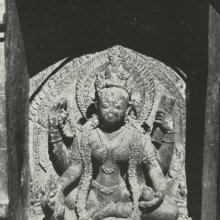Vagishvari, Vāgīśvarī: 8 definitions
Introduction:
Vagishvari means something in Hinduism, Sanskrit. If you want to know the exact meaning, history, etymology or English translation of this term then check out the descriptions on this page. Add your comment or reference to a book if you want to contribute to this summary article.
The Sanskrit term Vāgīśvarī can be transliterated into English as Vagisvari or Vagishvari, using the IAST transliteration scheme (?).
Images (photo gallery)
In Hinduism
Shaivism (Shaiva philosophy)
Source: HAL: The alphabet goddess Mātṛkā in some early Śaiva TantrasVāgeśvarī or Vāgīśvarī, the goddess of Words, is often identified with Mātṛkā, although Vāgīśvarī is nottaken to be an alphabet goddess.

Shaiva (शैव, śaiva) or Shaivism (śaivism) represents a tradition of Hinduism worshiping Shiva as the supreme being. Closely related to Shaktism, Shaiva literature includes a range of scriptures, including Tantras, while the root of this tradition may be traced back to the ancient Vedas.
Purana and Itihasa (epic history)
Source: Cologne Digital Sanskrit Dictionaries: The Purana IndexVāgīśvarī (वागीश्वरी).—A Śakti created by Nṛsimha from his tongue on behalf of Rudra.*
- * Matsya-purāṇa 179. 63.

The Purana (पुराण, purāṇas) refers to Sanskrit literature preserving ancient India’s vast cultural history, including historical legends, religious ceremonies, various arts and sciences. The eighteen mahapuranas total over 400,000 shlokas (metrical couplets) and date to at least several centuries BCE.
Shaktism (Shakta philosophy)
Source: Kamakoti Mandali: The Yoginis of Narasimha VyuhaVāgīśvarī (वागीश्वरी) refers to one of the four Vyūhaśaktis and was created from Narasiṃha’s tongue after being pleased with Rudra’s prayers.—Accordingly, [...] though the demons were all killed, including the original Andhakāsura, the Mātṛkāgaṇas created by Rudra were still hungry and they began to attack the three worlds, devouring Devas and Humans. Failing to perform the upasaṃhāra of such a huge magnitude of Śaktis, Rudra meditated on Mahānṛsiṃha [...]. Pleased with Rudra’s prayers, Narasiṃha created four Vyūhaśaktis [viz., Vāgīśvarī]. The Lord created a group of Nṛsiṃha Yoginīs to accompany the three main Śaktis. [...] All of them, under the command of śuṣkarēvatī, attacked the Rudraśaktis, subdued them and pacified them to attain benevolence.
Source: Brill: Śaivism and the Tantric Traditions (shaktism)Pāṇicatuṣṭaya (पाणिचतुष्टय) refers to the “goddesses of speech”, according to the King Vatsarāja’s Pūjāstuti called the Kāmasiddhistuti (also Vāmakeśvarīstuti), guiding one through the worship of the Goddess Nityā.—Accordingly, “[...] I worship those eight goddesses of speech [i.e., Vāgīśvarī], Vaśinī and others, whose complexion is red. They carry in their four lovely hands a bow, arrows, a book, and a rosary. May the four deities of the weapons [of the Goddess]—the arrows and others—red in complexion, displaying the gestures of generosity and protection, marked on the head by their own respective weapon-forms, grant me permission [for worship of the Goddess]. [...]”.

Shakta (शाक्त, śākta) or Shaktism (śāktism) represents a tradition of Hinduism where the Goddess (Devi) is revered and worshipped. Shakta literature includes a range of scriptures, including various Agamas and Tantras, although its roots may be traced back to the Vedas.
Pancaratra (worship of Nārāyaṇa)
Source: archive.org: Catalogue of Pancaratra Agama Texts1) Vāgīśvarī (वागीश्वरी) is the name for a Mantra and Yantra discussed in the thirty-second chapter of the Jayākhyasaṃhitā: a Pāñcarātra Āgama text composed of 4500 verses in 33 chapters dealing with topics such as mantra (formulas), japa (repetitions), dhyāna (meditations), mudrā (gesticulations), nyāsa (concentrations) etc.—Description of the chapter [sādhanavidhi]:—Bhagavān says that previously he had made a passing reference to the vighneśamantra, and now He wants to discuss it in detail—namely how to achieve mastery of it, and the effects of so doing (1-36). He concludes his discussion of the prayogic mastery over the divine powers by turning to the vāgīśvarī-mantra (37-65) and how to employ the vāgīśarī-yantra (66-84).
2) Vāgīśvarī (वागीश्वरी) is the name of a Mantra mentioned in chapter 11 of the Brahmarātra section of the Sanatkumārasaṃhitā: an encyclopedic Sanskrit text written in over 3500 verses dealing with a variety of topics such as yoga, temple-building, consecration ceremonies, initiation and dhanurveda (martial arts).—Description of the chapter [mantra-kośa]: Sanatkumāra says that everything in this world can be obtained by employing mantra-formulas properly (1-4a). He then gives (in prose) the mantras that Brahma revealed to him, in each case citing the bīja, astra, kavaca, etc. The mantras given are: [e.g., Vāgīśvarī] [...] The chapter closes by stating that the fruits obtained through reciting mantra-formulas can be selected and varied by adding particular suffixes and prefixes to the set formulas .

Pancaratra (पाञ्चरात्र, pāñcarātra) represents a tradition of Hinduism where Narayana is revered and worshipped. Closeley related to Vaishnavism, the Pancaratra literature includes various Agamas and tantras incorporating many Vaishnava philosophies.
Languages of India and abroad
Sanskrit dictionary
Source: Cologne Digital Sanskrit Dictionaries: Monier-Williams Sanskrit-English DictionaryVāgīśvarī (वागीश्वरी):—[=vāg-īśvarī] [from vāg-īśvara > vāg > vāc] f. Name of Sarasvatī, [Catalogue(s)]
Source: DDSA: Paia-sadda-mahannavo; a comprehensive Prakrit Hindi dictionary (S)Vāgīśvarī (वागीश्वरी) in the Sanskrit language is related to the Prakrit word: Vāesarī.
Sanskrit, also spelled संस्कृतम् (saṃskṛtam), is an ancient language of India commonly seen as the grandmother of the Indo-European language family (even English!). Closely allied with Prakrit and Pali, Sanskrit is more exhaustive in both grammar and terms and has the most extensive collection of literature in the world, greatly surpassing its sister-languages Greek and Latin.
Kannada-English dictionary
Source: Alar: Kannada-English corpusVāgīśvari (ವಾಗೀಶ್ವರಿ):—[noun] the Speech-Goddess, Sarasvati.
Kannada is a Dravidian language (as opposed to the Indo-European language family) mainly spoken in the southwestern region of India.
See also (Relevant definitions)
Partial matches: Ishvari, Vac.
Starts with: Vagishvaridatta, Vagishvarimantra, Vagishvaristotra.
Query error!
Full-text (+13): Vagishvaristotra, Vagishvaridatta, Nakulivagishvarimantravidhana, Vaesari, Vagishvarimantra, Molikkilatti, Cakrahridaya, Bhishanika, Vyomacarini, Sukshmahridaya, Kurukulla, Sarvaklishta, Vrikshavesha, Ashmadarshana, Garutpakshahrida, Bharuti, Uttaramalika, Kanthakarni, Mahanaya, Ajita.
Relevant text
Search found 16 books and stories containing Vagishvari, Vag-ishvari, Vāg-īśvarī, Vag-isvari, Vāgīśvarī, Vagisvari, Vāgīśvari; (plurals include: Vagishvaris, ishvaris, īśvarīs, isvaris, Vāgīśvarīs, Vagisvaris, Vāgīśvaris). You can also click to the full overview containing English textual excerpts. Below are direct links for the most relevant articles:
Isanasivagurudeva Paddhati (study) (by J. P. Prajith)
15. Description of Vagishvari (rites and ritual) < [Chapter 4 - Worship of Gods and Goddesses]
2. Important deities in Isanasivagurudeva-paddhati < [Chapter 3 - Depiction of Gods and Goddesses]
26. Pratishtha and Nityotsava-vidhi of Sarasvati < [Chapter 4 - Worship of Gods and Goddesses]
Notices of Sanskrit Manuscripts (by Rajendralala Mitra)
Agni Purana (by N. Gangadharan)
Chapter 319 - Mode of worshipping Vāgīśvarī (Goddess of speech)
Chapter 84 - Mode of Initiation for Emancipation (nirvāṇa-dīkṣā)
Chapter 85 - Mode of purifying the Beatific principle of establishment
Brahma Purana (critical study) (by Surabhi H. Trivedi)
24. Honouring Guests < [Social and Economic Life]
Linga Purana (by J. L. Shastri)
Chapter 25 - The holy rites of fire pertaining to Śiva < [Section 2 - Pūrvabhāga]
Devi Tantra, Mantra, Yantra (study) (by Srider Basudevan Iyer)
Later Vedic goddesses (7): Sarasvati < [Chapter 2 - The Maior Goddesses]
Later Vedic goddesses (5.2): Mahalakshmi < [Chapter 2 - The Maior Goddesses]

